
The Adoration of the Magi is a painting by the Italian Renaissance painter Pietro Perugino, housed in the Galleria Nazionale dell'Umbria of Perugia, Italy.

The Tezi Altarpiece is a painting by the Italian Renaissance painter Pietro Perugino, housed in the Galleria Nazionale dell'Umbria of Perugia, Italy. The work was once associated to a single predella panel portraying the Last Supper, now at the Gemäldegalerie of Berlin.

Annunciation of Fano is a painting by the Italian Renaissance artist Pietro Perugino, executed around 1488–1490, and housed in the church of Santa Maria Nuova, Fano, Italy.
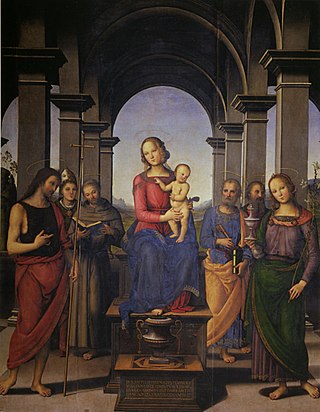
The Fano Altarpiece is a painting by the Italian Renaissance artist Pietro Perugino, executed in 1497, and housed in the church of Santa Maria Nuova, Fano, central Italy. It also includes a lunette with a Pietà and several predella panels.

Pietà is a painting by the Italian Renaissance artist Pietro Perugino, executed around 1483-1493, and housed in the Uffizi Gallery, Florence.

Agony in the Garden is a painting by the Italian Renaissance artist Pietro Perugino, executed around 1483-1493, and housed in the Uffizi Gallery, Florence.

The San Francesco al Prato Resurrection is a painting by the Italian Renaissance painter Pietro Perugino, dating to c. 1499. It is housed in the Pinacoteca Vaticana, Rome.
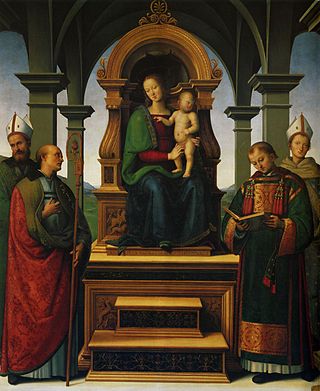
Decemviri Altarpiece is a painting by the Italian Renaissance artist Pietro Perugino, executed in 1495–1496, and housed in the Pinacoteca Vaticana in Vatican City.
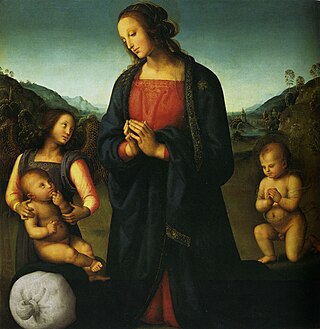
Madonna del Sacco is an oil on panel painting by Perugino, dating to around 1495–1500. It shows the Madonna and Child with the infant John the Baptist and an angel. It is now in the Galleria Palatina in Florence.
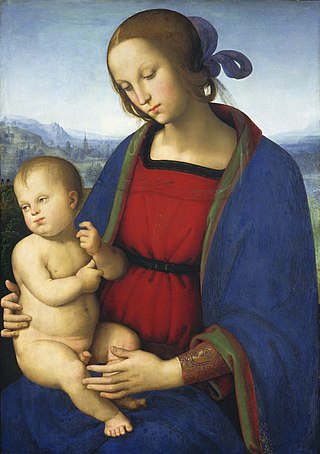
Madonna and Child is an oil on oak panel painting by Perugino. It dates to around 1501 and is now in the National Gallery of Art in Washington.
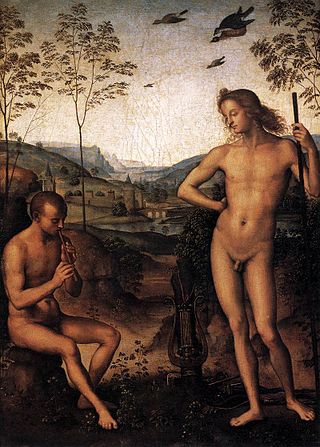
Apollo and Daphnis is a c.1483 mythological painting by Perugino. It was sold to the Louvre in Paris in 1883, where it still hangs and in whose catalogue it was known as Apollo and Marsyas. By the 1880s it had become misattributed to Raphael.

The Sant'Agostino Altarpiece is a painting by Perugino, produced in two stages between around 1502 and 1512 and then around 1513 to 1523. The altarpiece's 28, 29 or 30 panels were split up during the Napoleonic suppression of religious houses - most of its panels are now in the Galleria Nazionale dell'Umbria in Perugia. It is notable as the painter's last masterwork before he moved into his late phase producing more provincial commissions.

The Gonfalon of Justice is a tempera and oil on canvas painting by Perugino, dating to around 1501 and now housed in the Galleria Nazionale dell'Umbria in Perugia.

Crucifixion is a painting of the Crucifixion of Christ, usually attributed to Perugino, with or without assistance from Luca Signorelli. The work's dating and attribution are both uncertain - Venturi and Schmarsow attribute it to a pupil of Perugino, whilst other art historians attribute it to Perugino alone or with assistance from Signorelli. The deep chiaroscuro is comparable to Signorelli's style elsewhere or to the early style of Perugino whilst he was still heavily influenced by Verrochio. The landscape background is typical of Perugino, with mountains and hills in deep perspective.

Nativity of the Virgin is a small painting in tempera on panel by Pietro Perugino, dating to around 1472. It is held in the Walker Art Gallery, in Liverpool. It shows the nativity of Mary. The style of the house is heavily influenced by Andrea del Verrocchio.

The Monteripido Altarpiece is a double-sided altarpiece by Perugino, completed in 1502 for San Francesco al Monte church in Monteripido near Perugia. It is now in the Galleria Nazionale dell'Umbria in Perugia.

St Sebastian is one of several paintings of Saint Sebastian by Perugino. It shows him three-quarter length and is signed "P[I]E[T]RUS PERUSINUS PINXIT" on the arrow in his neck. It was painted in 1493–1494. It is now in the Hermitage Museum in St Petersburg.

St Sebastian is an oil on panel painting by Perugino, completed c. 1490. The painting has been in the Nationalmuseum in Stockholm since 1928. It is one of the artist's earliest depictions of Saint Sebastian, showing him as an ephebos, or male adolescent, unlike his later treatments based on the Doryphoros, such as that in the Louvre. It is signed "Petrus Perusinus pinxit".
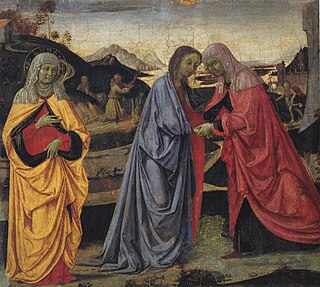
Visitation is a tempera on panel painting usually attributed to Perugino, executed c. 1472–1473, now in the Galleria dell'Accademia in Florence. An early work by the artist from around the same time as Nativity of the Virgin, whilst he was still heavily influenced by Andrea del Verrocchio, it probably originated as part of the predella for a lost altarpiece. It shows the Visitation, with the Virgin Mary's mother Saint Anne to the left. In the left background is Francis of Assisi receiving the stigmata and in the right background is Florence's patron saint John the Baptist - this may indicate that the lost altarpiece was intended for a Franciscan monastery in Florence such as Santa Croce.
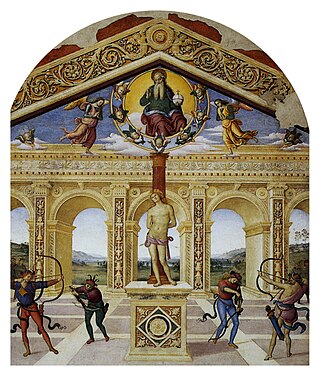
The Martyrdom of St Sebastian is a 1505 fresco painting by Perugino in the church of San Sebastiano in Panicale. It shows the martyrdom of St Sebastian in an ancient Roman setting, with God the Father in a tondo above.





















